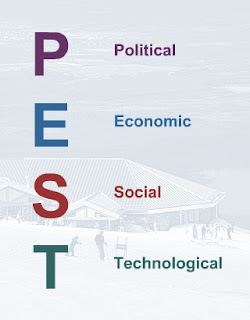1. Definition of PEST Analysis
4. Marketing Audit of Nike's Stategies
http://gwendolyncuizon.suite101.com/marketing-audit-of-nikes-strategies-a94402
http://gwendolyncuizon.suite101.com/marketing-audit-of-nikes-strategies-a94402
========================================================================
In this lecture, we have learnt about 2 strategic framework including PEST and SWOT. They enable us to identify the business objective through specifying the internal and external factors affecting the business. These two strategic analysis are often used together in a complementary manner.
Component of SWOT
1. Strengths
- Unique, competitive advantages that the company possessed attributing to the business objective achievement.
- Some possible strengths are superior product/ service quality or successful development of an innovative information system (its competitor didn't have and achieve operational efficiency improvement).
2. Weaknesses
- Limitation, competitive disadvantages of the company which should be improved and avoided.
- Some possible weaknesses are lack of resources/ skills and poor management.
3. Opportunities
- Favorable external condition, environmental trend for achieving business objective.
- Some possible opportunities are change in technology like the emergence of e-commence helps the companies to perform transactions over the Internet in a more effective and customized manner.
4. Threats
- Unfavorable external condition, environmental trend for achieving business objective.
- Some possible threats are the increase in inflation rate leading to the increase in cost of production..
Classification of internal/ external and positive/ negative impact as well as more example of the 4 aspects are shown as below.
Simply problem/ issue identification is insufficient. Of course, accurate and clear identification do take credit to the objective specification as well as further development of business process. We should do more than that. Below are some question we can ask ourselves after identifying the SWOT.
We can then think of which specific type of strategy we should implement according to our analysis. Below are some reference.
SWOT - Case study (Nike)
Here come Nike as an example to illustrate the point. Nike is a multinational company which has contracted with more than 700 shops around the world and has offices located in 45 countries apart form the US.
1. Strengths
- Global, well known brand name
- Global, well known brand name
- Long history of development (founded in 1964)
- Strong Research and Development (fashionable design)
- Competitive organization, significant market share in footwear product
2. Weaknesses
- Not diversified product range (focus on sports products)
- Vulnerable, over-concentrated income source (footwear market)
- Price sensitive retail sector
3. Opportunities
- High demand on footwear (sports event or casual wear, highly replaceable)
- Offer associated high value, profitable product (e.g. sunglasses, sportwear, etc.)
- Strong global brand recognition, many market segments
4. Threats
- International nature of trade (transaction in different currencies leading to unstable cost and profit margin)
- Stiff competition for sports shoes and garments market
- Price sensitive retail sector
More example can be found in the website below which I found quite useful for my understanding.http://www.cps.ca.gov/workforceplanning/documents/SampleCompletedSWOTAnalysis.pdf
Component of PEST
1. Political
- Government policy/ regulation and legal issue that intervene the economy
- Example: Trading policy(Terms of Trade), taxation and tariff control, etc.
2. Economic
- Impose direct impact on the customers' purchasing power and organization's cost of capital
- Example: Inflation rate, unemployment rate, interest rate, etc.
3. Social/ Socio-Cultural
- Cultural and demographical aspects affecting customers' need and potential market
- Example: Education level, changing lifestyle, attitude towards career and environment, etc.
4. Technological
- Leading to more efficient production and globalization
- Example: Machine and Automation, R&D, technological innovation rate etc.
More examples will be shown below:

PEST - Case Study (Nike)
1. Political
- Government policy (US) : low interest rate, stable currency condition
- Minimum wage policy
- Different term of trade/ trading policy in different countries
2. Economic
- Global economic recession/ downturn
- High inflation rate
- Fluctuating exchange rate
(reducing customers' purchasing power/ increasing labour and raw material cost)
3. Social
- Increasing health conscious (increasing exercise time/ participation in fitness club leading to increase in demand in sports product)
- Fashionable trend (middle class product, people especially teenagers are willing to purchase and replace the non-stylish sports shoes according to the trend)
- Labour right exploitation problem
4. Technological
- Effective marketing information system
- Online product review/ catelogue
========================================================================
Comment on Jane Leung's Lecture 3 - Strategic Framework and eBiz
She gives a clear definition of SWOT and PEST. ParknShop is a good example demonstrating the application of SWOT and PEST. She give a comprehensive and detailed analysis of it which deepen my understanding on the theory. For the social aspect in SWOT, I indeed agree that inflation rate do affect the demand of products. Therefore, customers often rely on the price cut or special discount. For the technological aspect, apart from the collection of customers' data, the use of the Internet enable customers to compare price of different supermarkets more easily. The competition between those supermarkets is intensified due to the increasing transparency.








